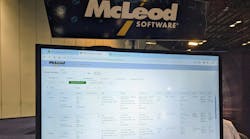Blockchain technology is said to streamline payment transactions – and possibly eliminate the middleman – in trucking. We’ve also heard that early adopters of blockchain will have an advantage over companies who drag their feet. And most recently we heard, “Blockchain is coming. Get ready for it.”
Week after week, it seems like blockchain – a technology platform that allows for secured and immutable exchange of information – is gaining more and more momentum in the industry.
Brad Taylor, vice president of data and IOT solutions at Omnitracs, said the company became interested in joining the Blockchain in Transport Alliance (BiTA) back when it formed in September 2017. Omnitracs recently joined the BiTA board, which is setting the governance standards for blockchain in transportation and logistics, after its customer P&S Transportation joined.
“We had been tracking blockchain internally but we wanted to see to a certain extent what was going to happen in the industry and how quick the uptake was going to be,” Taylor told Fleet Owner. “We were very pleased to see how quickly the interest expanded. I think P&S recognized the value of being added early on.”
Taylor added that he believes there will be a full, industry-wide adoption of blockchain in the next couple of years. “I’ve been surprised with the momentum and the interest from the industry,” he said.
Mauricio Paredes, vice president of business technology at P&S, explained the company joined BiTA early on due to the appeal of securely sharing data among all the parties in the supply chain and the efficiencies it will bring to P&S and its affiliates.
The specific example that got the company’s management behind BiTA was the idea of a digitalized bill of lading (BOL).
“Currently, we have many processes that are bound to that particular piece of paper (or an image of it) moving through the delivery process,” he noted. “Having a digital BOL, securely placed on the blockchain, will streamline every single process for any carrier.”
Using blockchain to navigate ELD and HOS data
Blockchain is expected to provide an instant audit for electronic logging devices (ELDs) and truck drivers’ hours of service (HOS). Paredes explained that since every transaction within the chain is immutable once committed, fleet executives would have an unchangeable version of drivers’ service hours.
This “could be complemented with additional data points,” he noted. “For example, we can write the fuel purchase time stamp to the same chain, their parking stops, etc. It’s an instant audit.”
Additionally, ELDs posting location times to the blockchain could help carriers instantly confirm with their customers of arrivals and departures.
Omnitracs’ Taylor pointed out, however, that one of the biggest hurdles the industry has to overcome when it comes to blockchain is how it validates and shares hours of service.
“The new ELD requirements have placed tremendous emphasis on maintaining the privacy of the driver while still having the ELD as an effective tool to enforce safety standards through what driving hours are being observed,” he stressed.
“I think that blockchain has a lot of potential for that because you want to be able to share maybe parts of the driving record – meaning the times that you’re on your way and driving on a commercial basis in the delivery process,” Taylor added. “But we don’t want to provide information about details that would break the visibility the driver needs to have for their personal conveyance, as an example. Blockchain has tremendous potential in that area, but we still have to have regulatory approvals to do things like that.”
Earlier this month, Konexial, provider of the My20 ELD, also joined BiTA. Konexial CEO Ken Evans said that the company’s GoLoad load-matching platform will be enabled for blockchain transactions in the third quarter of 2018.
“When you look at what we’re doing with dynamic load matching under the GoLoad product, we are bringing many people together under different operating environments,” Evans explained. “So people who are a good fit for each other but never had the opportunity to transact before are meeting for the first time. And that presents some challenges. One of the challenges is how do I trust the counter party?”
Evans said that as the company continues to develop its load-matching platform it has made sense for it to have a way in which its customers can pay each other in a trusted fashion.
Evans believes that blockchain can eventually replace the practice of "factoring," wherein carriers sell their accounts receivable at a discount in order to maximize cash flow.
“Carriers having been losing money through factoring for years—blockchain has the ability to help carriers, especially the small owner-operators, run stronger, healthier businesses,” Evans added. “We see it as another way for Konexial to help solve the most obvious problems for truckers.”
Although Taylor said he expects there will be private blockchains and initiatives made by individual technology vendors, when it comes down to it, he thinks the standards being catalyzed by BiTA are likely to drive adoption because of the industry leaders already participating in this discussion.
“It’s understood upfront that we’re going to be sharing the standards and the information and defining data sources that will be facilitating this sharing,” Taylor said.





